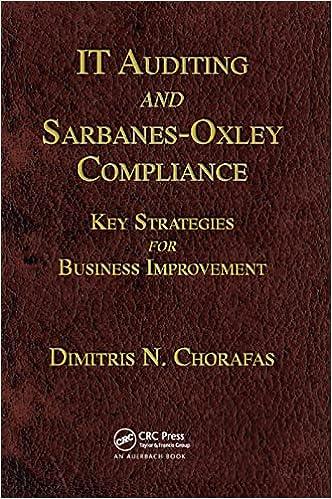Question
Table 2.1. Example data for all units discount. Quantity Purchased Per-Unit Price 0100 $5.00 101250 $4.50 251 and higher $4.00 If the buyer purchases 100
Table 2.1. Example data for all units discount. Quantity Purchased Per-Unit Price 0100 $5.00 101250 $4.50 251 and higher $4.00 If the buyer purchases 100 or fewer units, he pays $5 for each unit purchased. If he purchases at least 101 but no more than 250 units, he pays $4.50 for each unit C3/unit Total Purchasing Cost C1/unit C2/unit q2 q3 q4 Order Quantity (Q) purchased. Thus the cost of purchasing 150 units in a single order is (150)(4.5) = $675. Similarly, his purchasing cost comes down to only $4.00 per unit if he purchases at least 251 units. Therefore, in the all units discounts model, as the order quantity increases, the unit purchasing cost decreases for every unit purchased. Figure 2.4 shows the total purchasing cost function for the all units discounts. Fig. 2.4. Total purchasing cost for all units discount. The incremental quantity discount is an alternative type of discount. Let us consider an example. Here the unit purchasing price is $1.00 for every unit up to 200 units. If Table 2.2. Example data for incremental quantity discount. Quantity Purchased Per-Unit Price 0 200 $1.00 201500 $0.98 501 and higher $0.95 the order quantity is between 201 and 500, the unit purchasing price drops to $0.98 but only for units numbered 201 through 500. The total purchasing cost of 300 units will be (200)(1)+(300200)(0.98) = $298. Similarly, if at least 501 units are purchased, the unit purchasing price decreases to $0.95 for units numbered 501, 502, etc. Therefore, in the incremental quantity discounts case, the unit purchasing cost decreases only for units beyond a certain threshold and not for every unit as in the all units discounts case. Figure 2.5 illustrates the total purchasing cost function. Why are these discounts offered by suppliers? The reason is to make the customers purchase more per order. As we learned before, C3/unit Total Purchasing Cost C1/unit C2/unit q2 q3 q4 Order Quantity (Q) Fig. 2.5. Total purchasing cost for incremental quantity discount. large orders result in high inventory holding costs because an average unit spends a longer time in the system before it gets sold. Thus the sellers price discount subsidizes the buyers inventory holding cost. We will begin with an analysis of the all units discounts contract. We want to find the order quantity that minimizes the average annual sum of the purchasing, holding, and fixed ordering costs.
Step by Step Solution
There are 3 Steps involved in it
Step: 1

Get Instant Access to Expert-Tailored Solutions
See step-by-step solutions with expert insights and AI powered tools for academic success
Step: 2

Step: 3

Ace Your Homework with AI
Get the answers you need in no time with our AI-driven, step-by-step assistance
Get Started


